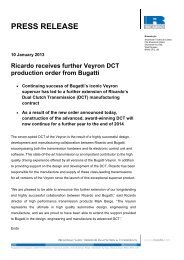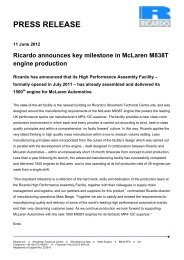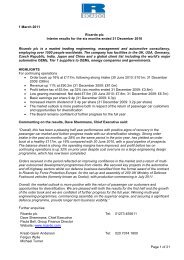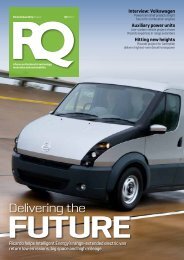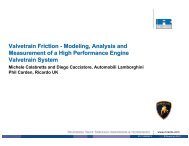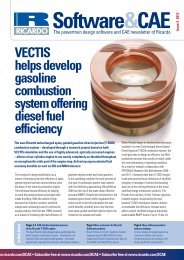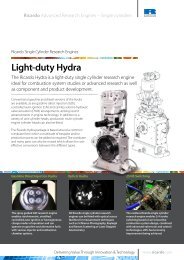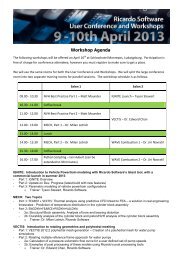Case Study - Ricardo
Case Study - Ricardo
Case Study - Ricardo
Create successful ePaper yourself
Turn your PDF publications into a flip-book with our unique Google optimized e-Paper software.
<strong>Case</strong> <strong>Study</strong>
High-speed flywheels are a cheap and efficient way to hybridise<br />
systems from cars, elevators and industrial machinery to inter-city trains.<br />
Yet until now their development has been hindered by the lack of a<br />
robust way to transmit the power to and from them. Jesse Crosse<br />
reports on some ingenious new developments at <strong>Ricardo</strong><br />
Designing products which<br />
consume less energy has shot<br />
to the top of the agenda in this<br />
energy-hungry world – not just in the<br />
automotive business but in any industry<br />
delivering mechanical products which<br />
do work for our benefit.<br />
Recovering kinetic energy from<br />
objects that have been accelerated, and<br />
then re-using that energy, is one way<br />
of cutting consumption. For example,<br />
when a vehicle is accelerated from rest<br />
by the engine, the kinetic energy in that<br />
vehicle is usually wasted when the time<br />
comes to slow down, either through<br />
frictional losses and aerodynamic drag<br />
when coasting, or heat when braking.<br />
In electric vehicles, this energy<br />
can easily be recovered and re-used<br />
by using the electric drive motor<br />
as a generator to slow the vehicle,
generating electricity in the process. In<br />
cars, this electrical energy is typically<br />
stored in a battery or ultra-capacitor<br />
and then re-used when the driver wants<br />
to accelerate again, whereas in rail<br />
applications electricity can be fed back<br />
into the power distribution system via<br />
the overhead catenary or conductor<br />
rails. However another and potentially<br />
much more cost-effective method, not<br />
just for electric vehicles but for those<br />
powered by traditional combustion<br />
engines as well, is the flywheel.<br />
Flywheels make great children’s<br />
toys in the form of spinning tops,<br />
gyroscopes and yo-yos, but they are<br />
also hugely effective energy storage<br />
devices. Decelerate a car by energising<br />
a flywheel rather than wastefully using<br />
the brakes and the energy it stores can<br />
be used the next time the driver wants<br />
to accelerate.<br />
Hybrids, Formula One and flywheels<br />
<strong>Ricardo</strong> has substantial experience in<br />
flywheel hybrid system development.<br />
It has investigated many different kinds<br />
of energy recovery technologies such<br />
as ultra-capacitors, hydraulic systems,<br />
electric flywheels and mechanical<br />
flywheels – including the engineering of<br />
kinetic energy recovery systems (KERS)<br />
for Formula One applications. As a<br />
result of this work <strong>Ricardo</strong> has devised<br />
‘Kinergy’, a compact, light weight, highspeed,<br />
hermetically-sealed flywheel<br />
energy storage system concept with<br />
a highly innovative and patented<br />
magnetic gearing and coupling<br />
mechanism.<br />
Modern carbon fibre based flywheel<br />
systems such as Kinergy can typically<br />
operate at speeds of around 60,000<br />
rev/min. With consequent outer<br />
surface speeds of around Mach 2 a<br />
vacuum is essential as friction from<br />
any surrounding air would cause the<br />
carbon fibre to quickly overheat and
The <strong>Ricardo</strong><br />
Kinergy highspeed,<br />
hermeticallysealed<br />
flywheel<br />
energy storage<br />
system concept,<br />
showing its<br />
patented magnetic<br />
gearing and<br />
coupling mechanism<br />
<br />
<br />
<br />
<br />
de-laminate.<br />
The high power density and longlife<br />
potential of Kinergy technology<br />
results from its inherent simplicity and<br />
effectiveness, avoiding the need for<br />
vacuum pumps and seals and offering<br />
a robust, compact and lightweight<br />
package. The simplicity of its design<br />
also yields comparatively very low<br />
projected production costs, thus<br />
opening the door to a wide range of<br />
potential applications.<br />
The technology appears ideally<br />
suited for application in passenger<br />
cars ranging from small, pricesensitive<br />
mass-market models to<br />
large luxury SUVs, enabling the<br />
effective hybridisation of a wide range<br />
of applications where conventional<br />
electro-chemical battery systems<br />
would be prohibitively expensive.<br />
Potential additional Kinergy<br />
applications also include low-cost,<br />
compact energy management and<br />
storage systems for use in industrial<br />
and construction equipment and<br />
local electrical substations and power<br />
distribution systems.<br />
Scaleable energy store<br />
A flywheel is a relatively simple energy<br />
store. It is scalable, modular and has a<br />
high power density, which means it can<br />
absorb and release energy very quickly.<br />
Unlike battery systems, with their much<br />
higher energy density but much slower<br />
ability to absorb and release it over<br />
time, modern flywheel systems are<br />
thus much closer to ultra-capacitors<br />
in operation, making them ideal for<br />
delivering short bursts of power, such<br />
as during acceleration.<br />
Flywheels are hence in effect a<br />
complementary technology to batteries<br />
but in an electric hybrid powertrain<br />
they offer direct competition to ultracapacitors,<br />
out-scoring them in terms<br />
of cost, volume, weight, efficiency<br />
and ease of manufacture. A battery<br />
has to be sized for energy capacity,<br />
power and the number of charge<br />
and discharge cycles it can<br />
withstand. But with the Kinergy<br />
system, a continuously<br />
variable transmission (CVT)<br />
determines power output<br />
and the flywheel speed.<br />
Both can be optimised to<br />
achieve the balance of<br />
power and duration of<br />
output needed<br />
Although this<br />
approach is entirely<br />
mechanical, the<br />
flywheel can also<br />
be connected to<br />
an electric motorgenerator<br />
and<br />
electrical system.<br />
It could also be<br />
connected to an<br />
hydraulic displacement<br />
unit rather than a CVT.<br />
Flywheels are<br />
extremely versatile<br />
devices. In a conventional<br />
car, they can be used to<br />
seamlessly feed power<br />
back into the powertrain,<br />
reducing the work done by the<br />
engine, saving fuel and reducing<br />
CO2 emissions. In a hybrid or electric<br />
vehicle, they reduce the drain on the<br />
battery, helping to extend the range.<br />
There are less obvious uses too.<br />
Dual clutch transmissions (DCTs) are<br />
becoming more popular because the<br />
lack of torque interruption provides<br />
the refinement of a torque converter<br />
automatic gearbox with the relative<br />
simplicity, efficiency and packaging<br />
benefits of a conventional manual<br />
gearbox. The simpler alternative<br />
to DCT, the automated manual<br />
transmission (AMT), is much cheaper<br />
to manufacture and equally efficient:<br />
however, it suffers from torque<br />
interruption during gearshifts, which<br />
often led to poor levels of refinement<br />
in fully automatic mode.<br />
<strong>Ricardo</strong> has a patent pending on<br />
a flywheel system which can fill the<br />
torque gap as the gearbox shifts. “The<br />
system is the same cost as a DCT and<br />
just as refined,” says <strong>Ricardo</strong> technical<br />
specialist, Andy Atkins. “However,<br />
because of the added hybrid function it<br />
delivers a 20 per cent reduction in fuel<br />
consumption as a bonus.”<br />
High-energy applications<br />
Beyond the passenger automotive<br />
sector, larger units are perfect for<br />
use in trucks, buses and passenger
The magnetic gear can be configured<br />
to give a reduction of 10:1, so if the<br />
flywheel is revolving at 60,000 rev/min,<br />
the output shaft can revolve at 6000<br />
rev/min, significantly reducing windage<br />
losses. Magnetic gears use permanent<br />
magnets to transmit torque through an<br />
airspace between two shafts, without<br />
the need for mechanical contact<br />
<strong>Ricardo</strong>’s system comprises a rotor<br />
on the output shaft of the flywheel<br />
rotating inside a cylindrical rotor on<br />
the power-take-off shaft. An array of<br />
permanent magnets is set into each<br />
and it is the attraction between the<br />
magnetic fields of these magnets that<br />
link the rotation of one shaft to another.<br />
One inherent difficulty in engineering<br />
this arrangement is achieving close<br />
enough proximity of the magnets<br />
for the principle to work, given the<br />
thickness of the casings. The peak field<br />
distance is at around a millimetre so<br />
the optimum distance between the<br />
two arrays of rotating magnets would<br />
be around double this – not enough<br />
to maintain an acceptable air gap and<br />
casing thickness. But installing ferrous<br />
pins in the casing wall transmits the<br />
magnetic field and the wall effectively<br />
disappears, allowing acceptable air<br />
gaps to be incorporated within a<br />
comfortable engineering tolerance.<br />
Efficiency is extremely high at more<br />
than 99.9 per cent, and the system is<br />
robust too. In the event of a serious<br />
torque spike, there are no gears to<br />
shear: instead the magnetic connection<br />
will slip and is quickly re-instated by<br />
simply backing-off the torque.<br />
Safety factor<br />
Achieving a sufficiently high safety<br />
factor in such high-speed components<br />
is clearly important. Kinergy’s carbon<br />
fibre flywheel has a margin of 12 times<br />
the ultimate tensile strength (UTS), or<br />
in other words, it is being stressed to<br />
one twelfth of the UTS of the carbon<br />
fibre material. The design is such that<br />
failure modes can be detected by<br />
the automatic monitoring of out of<br />
balance vibration by bearing sensors,<br />
enabling safe shut down before further<br />
consequential damage is caused. In the<br />
worst case, the external casing would in<br />
any case contain any failure.<br />
The major challenges will come with<br />
mass production, says Atkins. “Although<br />
relatively cheap to make in principle,<br />
winding the filament onto a bobbin<br />
is relatively time consuming. This<br />
means that increasing volumes in the<br />
production process may be a challenge.”<br />
Yet Kinergy is cost effective and it<br />
is estimated an entire unit integrated<br />
with a differential could be made for<br />
around $1500. The flywheel and CVT<br />
represent about a third each of the<br />
cost, with the differential and other<br />
equipment making up the rest. The<br />
unit would be substituted for the<br />
standard differential so there are<br />
savings to be made there too.<br />
Bearings are the only limiting factor<br />
and in practice these will ultimately<br />
decide the service life of the unit. The<br />
current state of the art is to use ceramic<br />
<br />
Following the public launch of<br />
Kinergy, <strong>Ricardo</strong> aims to further<br />
develop this highly promising<br />
technology and demonstrate its<br />
benefits in applications through<br />
research collaborations with a<br />
number of industrial partners. The<br />
first of these research collaborations,<br />
the FLYBUS project, will involve<br />
<strong>Ricardo</strong>, Torotrak, Optare and Allison<br />
Transmission. Part funded by the<br />
UK Government’s Technology<br />
Strategy Board, the FLYBUS will<br />
involve the development of a <strong>Ricardo</strong><br />
Kinergy flywheel energy storage<br />
device incorporating a Torotrak<br />
patented Continuously Variable<br />
Transmission (CVT) for installation in<br />
a demonstrator vehicle based on an<br />
Optare Solo bus. “Simulation work<br />
by Torotrak, based on an Optare Solo<br />
bus and using the readily available<br />
60kW system with 400kJ of energy<br />
storage capacity proposed for this<br />
first demonstrator, produced fuel<br />
savings of 20 per cent over the official<br />
UK bus test cycle,” explains Torotrak<br />
engineering director Roger Stone.<br />
“In this initial project, the CVT and<br />
flywheel hybrid system will be applied<br />
to the vehicle’s driveline through<br />
the existing and previously unused<br />
power take-off facility incorporated<br />
within the standard Allison automatic<br />
transmission. Further simulation<br />
shows that an optimised system,<br />
using a 110kW system with 1MJ<br />
energy storage capacity, will produce<br />
further significant improvements in<br />
fuel savings over the same test cycle.”<br />
This project demonstrates the<br />
practical potential of the application<br />
of the <strong>Ricardo</strong> Kinergy based system<br />
incorporating its Torotrak CVT either<br />
in the design of a new vehicle or as<br />
a retrofit product to an existing fleet.<br />
As Stone concludes: “Given the long<br />
service life of buses, the availability of<br />
a simple hybrid system – one which<br />
can be factory-fitted to new vehicles<br />
or retrofitted to an existing vehicle to<br />
radically reduce fuel costs and CO2<br />
emission levels, at modest cost – will<br />
be particularly welcomed by bus<br />
companies, commercial vehicle fleet<br />
operators, and government.”<br />
The KinerStor research project<br />
In a further research collaboration,<br />
<strong>Ricardo</strong> is leading the KinerStor<br />
project which aims to demonstrate<br />
the potential of using high speed<br />
flywheel technologies such as<br />
Kinergy, in delivering hybrid systems<br />
with the potential for 30 per cent fuel<br />
savings and equivalent reductions<br />
in CO2 emissions, at an on-cost of<br />
below £1000 ($1600), thus enabling<br />
the mass-market uptake of hybrid<br />
vehicles in price sensitive vehicle<br />
applications.<br />
The KinerStor project team<br />
aims to design, build and test a<br />
number of prototype units such<br />
that on completion, the developed
alls and steel races: these already last<br />
the life of the system. The only service<br />
requirement would be to reinstate the<br />
vacuum as the composite material used<br />
to make the flywheel seeks to balance<br />
its own internal water content with the<br />
atmosphere around it and water will<br />
continue to ‘boil’ out for some time.<br />
“This is all standard vacuum<br />
engineering practice, though,” says<br />
Atkins, “It’s a simple job which<br />
involves plugging in a vacuum line<br />
during a routine service. If we didn’t<br />
have the magnetic coupling, however,<br />
then we’d be doing that every couple<br />
of hours and you would need an onboard<br />
vacuum pump.”<br />
The rotating seals of a mechanically<br />
geared system would also wear, so the<br />
problem would get worse with time.<br />
Replacing these gears would involve<br />
a total break into the vacuum, with<br />
inevitable water ingress into the<br />
system and the pump would have<br />
to work a lot harder.<br />
To remove the need for any kind<br />
of maintenance, <strong>Ricardo</strong> has also<br />
developed a solid state pump which<br />
would mean never having to do<br />
anything at all. Known as ‘getter’<br />
technology, Atkins explains that<br />
this currently highly confidential<br />
technology is extremely promising: “it<br />
absorbs just about everything except<br />
hydrogen in a physical rather than a<br />
chemical process”.<br />
Many potential applications<br />
The list of applications is extensive,<br />
concludes Atkins, since flywheels<br />
are ideal for anything that involves<br />
intermittent flows of high power.<br />
“Flywheels are particularly good for<br />
vehicles that stop often – and the<br />
heavier the better,” he says. “So cars,<br />
trucks, trains, trams, buses, materials<br />
handling machinery such as cranes<br />
and elevators – and even White Van<br />
Man, as it works brilliantly for delivery<br />
vehicles! They’re also good for electrical<br />
power management systems where<br />
highly intermittent demands need to be<br />
smoothed, such as local distribution grid<br />
The highly compact<br />
Kinergy system as<br />
integrated into a<br />
rear axle assembly.<br />
or railway substations, in particular for<br />
example, mass transit and metro power<br />
networks which are required to manage<br />
regenerative braking loads from rolling<br />
stock being fed back into the conductor<br />
rails or overhead lines.”<br />
“<strong>Ricardo</strong>’s Kinergy technology<br />
is inherently cost-effective, robust,<br />
reliable and compact, giving it a huge<br />
potential for many such applications.<br />
Its highly compact size and light weight<br />
also makes it an ideal candidate for<br />
aftermarket system integration without<br />
affecting the original equipment design,<br />
on anything that requires a pulse of<br />
energy.” he adds.<br />
Without any doubt, the future looks<br />
good for flywheel technology. Proof<br />
comes in the form of the enquiries that<br />
are flooding in to the <strong>Ricardo</strong> offices<br />
as more people begin to understand<br />
that, when it comes to reducing energy<br />
consumption, few devices are quite<br />
so elegant in their simplicity, their<br />
efficiency and their cost<br />
effectiveness too.<br />
technologies are ready for vehiclebased<br />
installation, testing and<br />
demonstration. With collaborators<br />
including CTG, JCB, Land Rover,<br />
SKF, Torotrak and Williams Hybrid<br />
Power, KinerStor brings together<br />
a critical mass of relevant skills<br />
and expertise in specialist areas,<br />
including: advanced flywheel<br />
systems, focusing on new material<br />
technologies including low-cost<br />
composite fibres and specialist<br />
steels; continuously variable<br />
transmissions; bearing and coupling<br />
design; drivetrain integration, and<br />
volume vehicle manufacturing. The<br />
project’s structure will allow for<br />
the development of common coretechnology<br />
solutions which can be<br />
tailored to the individual needs of<br />
vehicle manufacturers.





